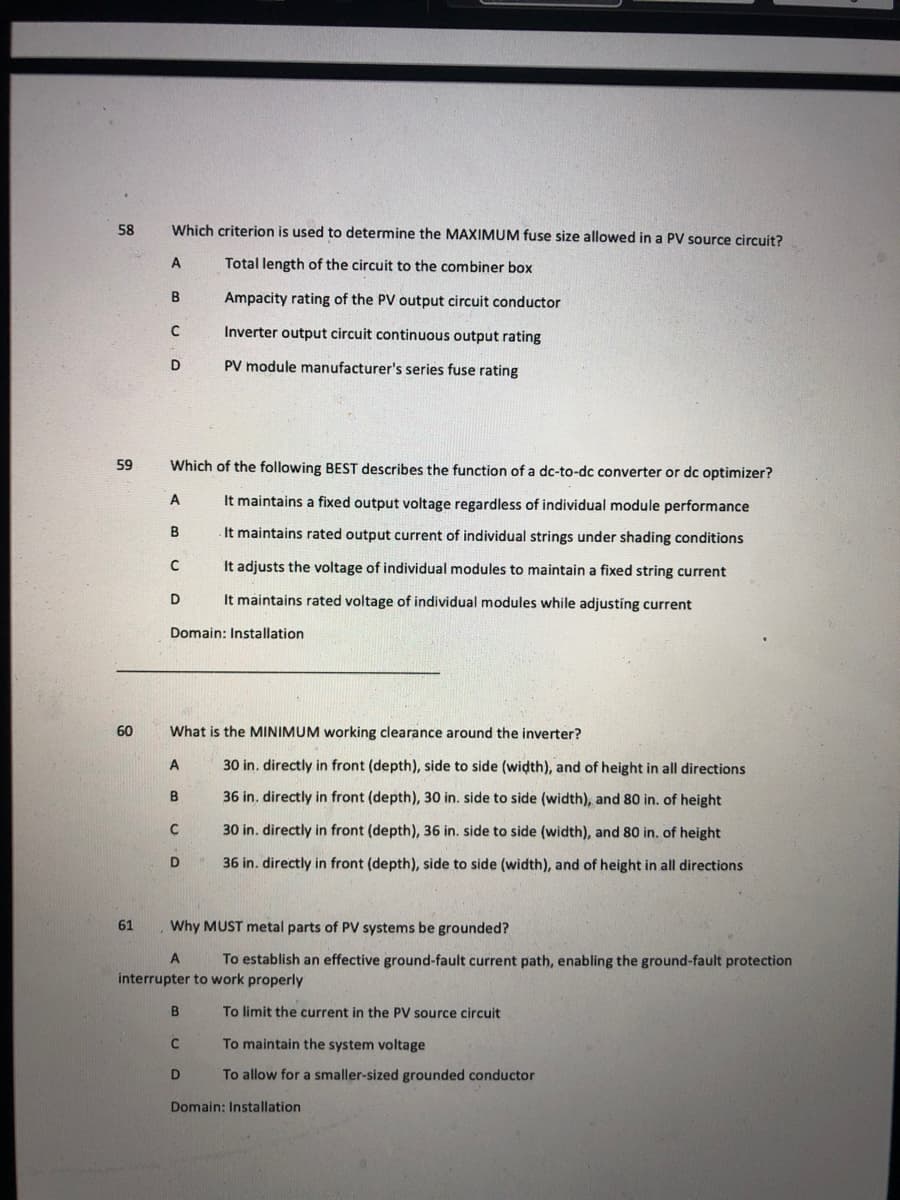58 Which criterion is used to determine the MAXIMUM fuse size allowed in a PV source circuit? Total length of the circuit to the combiner box B Ampacity rating of the PV output circuit conductor Inverter output circuit continuous output rating PV module manufacturer's series fuse rating 59 Which of the following BEST describes the function of a dc-to-dc converter or dc optimizer? A It maintains a fixed output voltage regardless of individual module performance It maintains rated output current of individual strings under shading conditions It adjusts the voltage of individual modules to maintain a fixed string current D It maintains rated voltage of individual modules while adjusting current Domain: Installation 60 What is the MINIMUM working clearance around the inverter? 30 in. directly in front (depth), side to side (width), and of height in all directions 36 in. directly in front (depth), 30 in. side to side (width), and 80 in. of height 30 in. directly in front (depth), 36 in. side to side (width), and 80 in. of height 36 in. directly in front (depth), side to side (width), and of height in all directions 61 Why MUST metal parts of PV systems be grounded? To establish an effective ground-fault current path, enabling the ground-fault protection interrupter to work properly To limit the current in the PV source circuit To maintain the system voltage To allow for a smaller-sized grounded conductor Domain: Installation
58 Which criterion is used to determine the MAXIMUM fuse size allowed in a PV source circuit? Total length of the circuit to the combiner box B Ampacity rating of the PV output circuit conductor Inverter output circuit continuous output rating PV module manufacturer's series fuse rating 59 Which of the following BEST describes the function of a dc-to-dc converter or dc optimizer? A It maintains a fixed output voltage regardless of individual module performance It maintains rated output current of individual strings under shading conditions It adjusts the voltage of individual modules to maintain a fixed string current D It maintains rated voltage of individual modules while adjusting current Domain: Installation 60 What is the MINIMUM working clearance around the inverter? 30 in. directly in front (depth), side to side (width), and of height in all directions 36 in. directly in front (depth), 30 in. side to side (width), and 80 in. of height 30 in. directly in front (depth), 36 in. side to side (width), and 80 in. of height 36 in. directly in front (depth), side to side (width), and of height in all directions 61 Why MUST metal parts of PV systems be grounded? To establish an effective ground-fault current path, enabling the ground-fault protection interrupter to work properly To limit the current in the PV source circuit To maintain the system voltage To allow for a smaller-sized grounded conductor Domain: Installation
Introductory Circuit Analysis (13th Edition)
13th Edition
ISBN:9780133923605
Author:Robert L. Boylestad
Publisher:Robert L. Boylestad
Chapter1: Introduction
Section: Chapter Questions
Problem 1P: Visit your local library (at school or home) and describe the extent to which it provides literature...
Related questions
Question

Transcribed Image Text:58
Which criterion is used to determine the MAXIMUM fuse size allowed in a PV source circuit?
A
Total length of the circuit to the combiner box
В
Ampacity rating of the PV output circuit conductor
Inverter output circuit continuous output rating
D
PV module manufacturer's series fuse rating
59
Which of the following BEST describes the function of a dc-to-dc converter or dc optimizer?
A
It maintains a fixed output voltage regardless of individual module performance
It maintains rated output current of individual strings under shading conditions
It adjusts the voltage of individual modules to maintain a fixed string current
D
It maintains rated voltage of individual modules while adjusting current
Domain: Installation
60
What is the MINIMUM working clearance around the inverter?
30 in. directly in front (depth), side to side (width), and of height in all directions
B
36 in. directly in front (depth), 30 in. side to side (width), and 80 in. of height
30 in. directly in front (depth), 36 in. side to side (width), and 80 in. of height
36 in. directly in front (depth), side to side (width), and of height in all directions
61
Why MUST metal parts of PV systems be grounded?
To establish an effective ground-fault current path, enabling the ground-fault protection
interrupter to work properly
B
To limit the current in the PV source circuit
To maintain the system voltage
D
To allow for a smaller-sized grounded conductor
Domain: Installation
Expert Solution
This question has been solved!
Explore an expertly crafted, step-by-step solution for a thorough understanding of key concepts.
This is a popular solution!
Trending now
This is a popular solution!
Step by step
Solved in 3 steps with 3 images

Knowledge Booster
Learn more about
Need a deep-dive on the concept behind this application? Look no further. Learn more about this topic, electrical-engineering and related others by exploring similar questions and additional content below.Recommended textbooks for you

Introductory Circuit Analysis (13th Edition)
Electrical Engineering
ISBN:
9780133923605
Author:
Robert L. Boylestad
Publisher:
PEARSON

Delmar's Standard Textbook Of Electricity
Electrical Engineering
ISBN:
9781337900348
Author:
Stephen L. Herman
Publisher:
Cengage Learning

Programmable Logic Controllers
Electrical Engineering
ISBN:
9780073373843
Author:
Frank D. Petruzella
Publisher:
McGraw-Hill Education

Introductory Circuit Analysis (13th Edition)
Electrical Engineering
ISBN:
9780133923605
Author:
Robert L. Boylestad
Publisher:
PEARSON

Delmar's Standard Textbook Of Electricity
Electrical Engineering
ISBN:
9781337900348
Author:
Stephen L. Herman
Publisher:
Cengage Learning

Programmable Logic Controllers
Electrical Engineering
ISBN:
9780073373843
Author:
Frank D. Petruzella
Publisher:
McGraw-Hill Education

Fundamentals of Electric Circuits
Electrical Engineering
ISBN:
9780078028229
Author:
Charles K Alexander, Matthew Sadiku
Publisher:
McGraw-Hill Education

Electric Circuits. (11th Edition)
Electrical Engineering
ISBN:
9780134746968
Author:
James W. Nilsson, Susan Riedel
Publisher:
PEARSON

Engineering Electromagnetics
Electrical Engineering
ISBN:
9780078028151
Author:
Hayt, William H. (william Hart), Jr, BUCK, John A.
Publisher:
Mcgraw-hill Education,